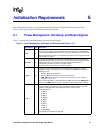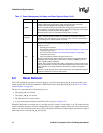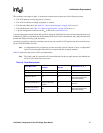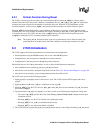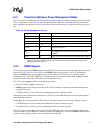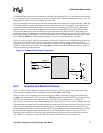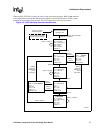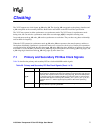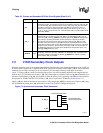
72 21555 Non-Transparent PCI-to-PCI Bridge User Manual
Initialization Requirements
6.4.3 Power Management Data Register
The PCI Power Management specification defines an optional data register that can be used for static or dynamic
data reporting. A Data Select field in the Power Management Control and Status register selects the type of data to
be reported. A Data Scale register provides the scale factor for this data. The 21555 allows implementation of this
Data register for static data reporting for the subsystem. The Data Scale value and eight possible data values are
loaded into the 21555 through the SROM preload operation. The Power Management Data Enable bit in the serial
preload sequence enables the use of these data values; otherwise the Data register reads as 0. The value contained in
the Data Select field selects which data byte is to be returned when the Power Management Data register is read.
6.5 CompactPCI Hot-Swap Functionality
The 21555 implements hot-swap functionality that allows it to function as a CompactPCI hot-swap controller. This
means that the software connection control interface for CompactPCI hot-swap is implemented. However, bus
precharge is not implemented. Please refer to the CompactPCI Hot-Swap Specification for more information on
CompactPCI hot-swap.
The basic components of a CompactPCI Hot-Swap device are:
• Table 125, “CompactPCI Hot-Swap Control Register” on page 189, at offset ECh.
— ENUM# Interrupt Mask. Must be clear to enable the assertion of p_enum_l.
— LOO (LED On/Off), LED software control bit. When set, the 21555 drives l_stat high, causing the LED
to turn on. When clear, the 21555 drives l_stat low, causing the LED to turn off.
Note: The 21555 periodically tristates l_stat for a few cycles to sample the state of the microswitch.
— INS_STAT, Insertion status bit.
— REM_STAT, removal status bit.
• Support of the hot-swap event pin, p_enum_l. This signal is routed to the host CPU through the CompactPCI
connector. This signal informs the CPU that the configuration of the system has changed; that is, the card has
been inserted or is about to be removed.
• Support bi-directional pin, l_stat. This signal functions as both a micro-switch sensor input and a LED control
output.
Note: 2 ms of debounce is implemented on the l_stat pin
.
6.5.1 Overview of CompactPCI Controller Hardware Interface
On the connector side, a CompactPCI hot-swap board has a staggered pin arrangement to allow
power/ground, signal, and a board inserted indicator to be connected and disconnected in stages.
Power and ground are 1
st
make, last (3
rd
) break pins. The signal pins are 2
nd
make, 2
nd
break pins.
The board inserted signal (BDSEL#), which is routed to the power conditioning and local reset
logic, is last (3
rd
) make, 1
st
break.
On the board handle side, a card ejector handle controls a micro-switch on the card. When a seated card is removed,
the first thing that occurs is that the ejector handle is opened. This causes the micro-switch to close. Similarly, when
a card is inserted, the ejector handle is initially open, and then closed when the board is seated. When the ejector
handle is closed, the micro-switch on the card opens. The micro-switch state is an input to the CompactPCI
hot-swap controller.




